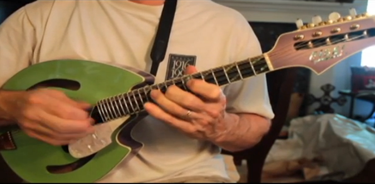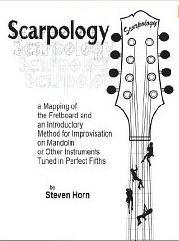« John McGann; Right hand considerations for flatpicking |
Main
| Fresh improv; spicing up your V7 chords »
 August 8, 2013 | Scarpology. Guaranteed freshness in improvisation. August 8, 2013 | Scarpology. Guaranteed freshness in improvisation.
Outside of the "just blow" method to improvisation, there are two practical approaches to developing soloing skills. One is to master "licks" or patterns of music you pick up listening to others. The 2nd approach is even more scientific, applying music theory by mastering scales and arpeggios.
There are advantages and disadvantages to each. Scales get you all members of the "appropriate" tones of the chord and subsequent passing tones. Learn a major or minor scale, a dorian or mixolydian mode and your on the path to creating melodies, albeit at the risk of sounding like you're playing scales. Arpeggios are great for communicating the harmonic nature of the music by literally spelling out the chords, but skipping around the fretboard leaves the listener wanting something linear. Plus, you miss the gravitational pull of the passing or preparation notes.
A mixture is always best. Learn your scales. Learn your arpeggios. Learn some licks. Our FFcP fundamental helps you with the first two, and we feel the systematic approach is a great way to transcend the mechanical and grind it into the intuitive. Play them so well that you forget them.
We've been enjoying a fresh new approach that combines some of this in a unique way , Texas musician/educator Steven Horn's "Scarpology." We're just starting to dig into this ourselves, and feel this is another one of those "leap ahead"methods of study that can open up your fretboard in ways you never dreamed. The idea is to break the scale into two octaves of arpeggios in a way that gets you thinking both chord and scale at the same time. It propels your access to harmonic fodder, and helps introduce modes and chord extensions in a revolutionary approach. It also moves you immediately into the entire real estate of the mandolin fretboard.

We hope to go deeper into this ourselves. Steve's website in itself is worth digging around, but we recommend you go the next step and actually purchase his book. Meantime, take some time to watch the video below, and if your curiosity is piqued, check out the next five in his introduction series.
Video Link: Scarpology
The book, Scarpology: a Mapping of the Fretboard and an Introductory Method for Improvisation on Mandolin or Other Instruments Tuned in Perfect Fifths is available in print from the author and in EBook format at Amazon Kindle Books and at Barnes and Noble Nook Books.
Link for Kindle
Link for Nook
Link to Author
Author's website: MandoSimean

Further:
Thin-slicing and Music Theory
Building a solo
Going beyond "playing."
Don Stiernberg on the "Big Picture" of improvising
Improvisation Techniques
Posted by Ted at August 8, 2013 7:03 AM

Disclaimer: In the 'Information Age' of the 21st Century,
any fool with a computer, a modem, and an idea can
become a self-professed 'expert." This site does not
come equipped with 'discernment.'
|



